Concealed Carry: All About Pocket Carry
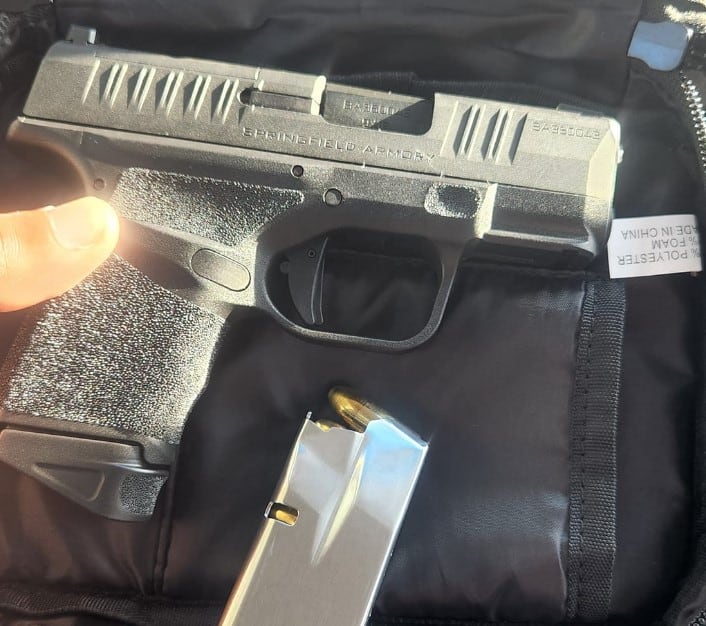
One of the things we like best about the gun world is their self-explanatory naming schemes. Of course, the same applies to this style of carrying as it does to any other.
In general, it is recommended to avoid carrying in the pocket as much as possible. However, as a general rule, you should carry it in your waistband if you can.
In my opinion, pocket carrying is one of the most effective ways to conceal a firearm when done properly.
Wearing the gun in your front or back pocket will determine your wardrobe and preferences. A more detailed discussion will follow.
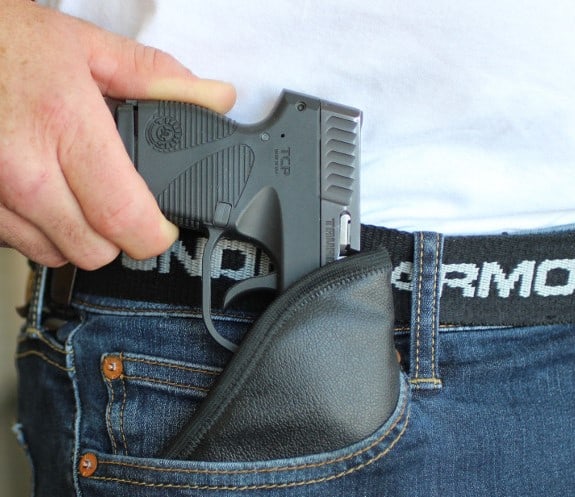
Is Pocket Carry A Good Option?
It is generally not a good idea to carry a concealed weapon in your pocket. This honor should be given to strongside carriers. Pocket carry can, however, be incredibly useful when in a hurry or in extreme weather.
It is sometimes impossible to carry something else. The pocket carry option is great if you need something different than the belt due to your career, lifestyle, or clothing.
A pocket carry handgun can be a safe and convenient option when other options are unavailable. If you have the right holster, pocket carry can be a great option.
When carrying one in a pocket, how should you do it? The following tips and tricks will help you.
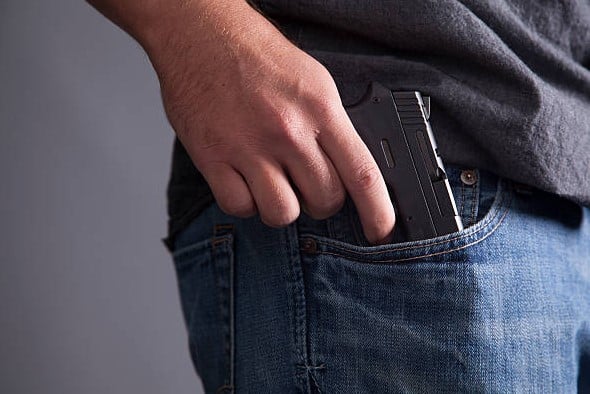
What Is Pocket Carry?
Gun naming schemes usually offer self-explanatory names – we love them. However, it is no different with this style of carrying. Carrying a firearm in your pocket is the concept of concealing it within the pocket of your pants.
Depending on your wardrobe and preferences, you can wear a front pocket or a back pocket.
In many cases, you can’t carry anything other than a handgun in your pocket. That’s why we don’t recommend pocket carry as our first choice for concealed carry.
Pocket carry is a convenient solution for those who need something separate from their belt due to their lifestyles, careers, or clothing.
Why Should You Pocket Carry?
It is tricky to carry a concealed handgun inside your pocket, and it also has its limitations. However, a pocket carry is a great option for low-profile carrying despite its drawbacks.
A Glock 43, S&W Shield, or SIG Sauer P365 are among the most common pocket-carry weapons. The lazy man’s carry option is what most people call pocket carry.
Pocket carry does work very well in some situations, however. For example, during the summertime, when it is extremely hot, pocket-carrying makes sense.
Now Is The Time To Get A Pocket Holster
It is essential to have a pocket holster. Taking the suggestions in this article will put you ahead of many other people who take unnecessary risks with their safety.
Holsters serve as both safety equipment for firearms and ways to carry a weapon. The safest way to carry a gun is in a holster.
Why Do You Need One?
Pocket holsters are essential for two reasons. First and foremost, the trigger needs to be protected. It is extremely difficult to distinguish an accidental discharge from a tiny snag, so nothing should be allowed to touch the trigger.
Search Google for “accidental discharge” or “negligent discharge.” You will find many instances of a loose trigger causing a pistol to discharge when the owner is pocket carrying without a holster.
As of today, striking pistols with light triggers and passive safety are the most popular pistols on the market. Although they aren’t inherently unsafe, they require the trigger to be protected throughout the entire process to be secure.
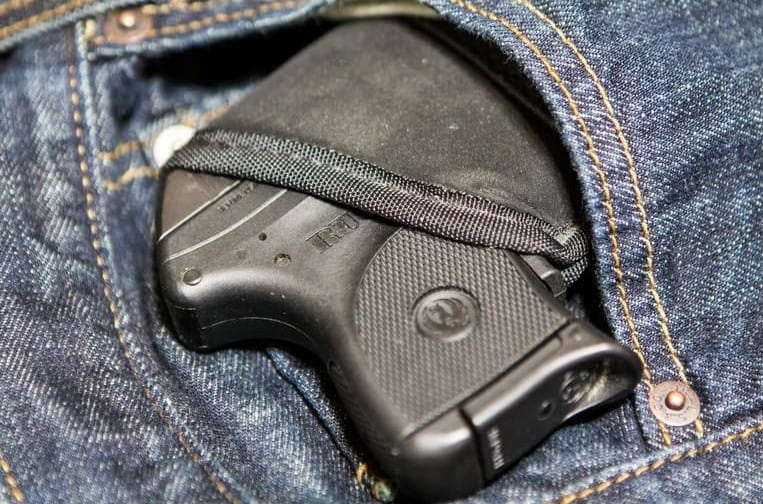
A trigger guard that is exposed puts you and everyone around you at risk, as well as putting your safety at risk. Therefore, such behavior cannot be tolerated.
The next step is to ensure that the concealment is drawn properly. Finally, if you want to carry a concealed weapon, you have to be able to get your gun into action.
You will easily snag the gun’s sights or other contours if you don’t use a concealed carry pocket holster.
The Best Tips for Successful Pocket Carry
There is a perfect reason why guns should never be carried without holsters and kept in pockets. Also, follow these tips below if you want to pocket carry.
Practice & Train
Since your skills determine the quality of your gear, we always end with practice and training. In addition to giving a good sense of how the carry setup will work in the real world, dry fire drills are a great way to train at home for free.
It would be best to try on different pants, place the holster and gun in the pocket, draw, and see how it goes. You should also practice from different positions – sitting and standing – to prepare for anything.
Pocket Holster Is The Keyword Here
It is imperative to wear a good holster when carrying a handgun. Never carry a pistol without a holster in your pocket. You don’t want to lose your Weiner.
Holsters can be divided into two types. In the first system, the gun is slipped into a sleeve, and then everything slides into a pocket.
Reholstering these means taking the holster out, which is collapsible. Reholstering these blindly in the pocket is not recommended.
Sleeve-style holsters are prone to coming out of pockets when you draw your gun. Even guns can get stuck with them sometimes.
Kydex is often used in this second style to create a barrier between the gun and the holster, making it slightly more effective. Holsters remain in pockets while guns are drawn in this manner.
You should be able to draw safely from a good holster regardless of how your gun is positioned.
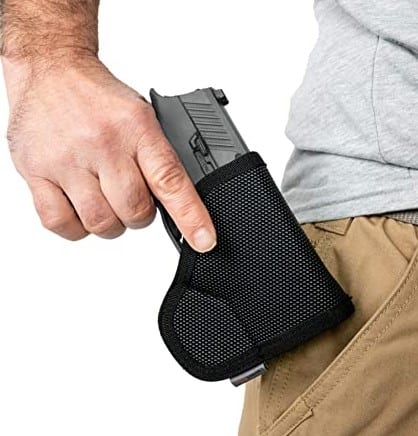
Choose Your Wardrobe Wisely
Identifying which outfits work and don’t work in your current wardrobe will help you narrow down your choices.
When it comes to pocket carry, pockets are the most important factor. A pistol and holster must fit comfortably in your pockets.
As long as you can reach your pocket if you need to, shirt length doesn’t matter as much as AIWB and IWB/OWB.
Why Pocket Carry Is a Good Idea
Although pocket carry does not require a belt, it has the biggest advantage of not requiring one. If you cannot carry an appendix or strong side, carrying a gun in your pocket is a great option. This makes it quite convenient.
There is no need to buy a gun belt or holster to use it. It is all it takes to take out your pocket holster (and put the gun in it).
Additionally, carrying a gun in your pocket can make you more discreet when drawing a weapon. When someone has their hands in their pocket, no one expects them to draw out a weapon, unlike in a regular IWB.
Having A Pocket Carry Has Its Cons
Pocket carrying does, however, have some disadvantages. One of the most limiting aspects of concealed carry is that it is not available to everyone.
Pocket carrying is not convenient for women because the size of their pockets (and sometimes the lack of pockets) prevents them from carrying things in their pockets. Unfortunately, there aren’t a lot of options in this category for the ladies.
A pair of men’s jeans is a good choice if you are serious about carrying a weapon. Also, men are not exempt from the fashion industry design changes.
You’ll need to check your closet for pants with pockets large enough to carry your concealed carry pistol if your pants aren’t designed for pocket carrying.
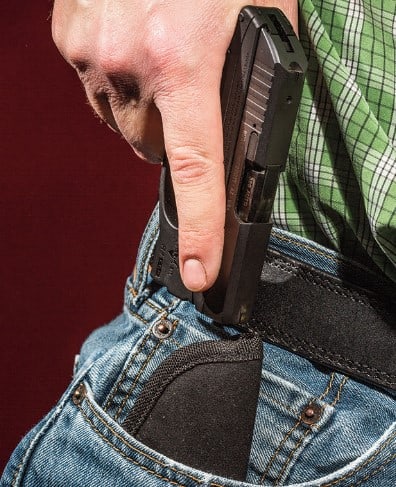
What Firearm Should You Carry In Your Pocket?
It is difficult to carry a firearm in your pocket because it is limited in size. Therefore, a micro-compact or subcompact firearm would benefit from this accessory.
Fans of the Glock 19 won’t like this one. But whatever the case may be, a small gun will be more challenging to draw from a pocket than from a holster. Consider this for a moment.
You need to dig into your pocket. Then you must conquer the pocket. Depending on the type of holster, the holster must be contained within the gun pocket.
Once that is done, you will need to draw your firearm. Although training can eliminate this obstacle, it is still less effective than holstered IWB, OWB, or AIWB guns.
How To Pocket Carry?
It is best to carry a pistol in the front pocket of your pants, the cargo pocket of your jacket, or the pocket of your cargo pants. It is possible to carry a wallet, but it will be more challenging. Furthermore, sitting is extremely uncomfortable.
Some also use pocket holsters to carry backup handguns, as well as for carrying their primary handgun in this manner. In the winter, accessing a waistband holster can be difficult, so some people carry their guns in their pockets. It’s up to you to make the decision.
It is, however, important to make sure pocket carrying is a good fit for you. Your top priority should be concealing effectively and safely. However, you should also make sure that the gun is accessible if needed. You’re essentially carrying around a paperweight without it.
If you choose the right gun and holster and practice a bit, you can carry concealed with a holster in your pocket.
Which Pocket Should I Carry It In?
There is no right or wrong answer – it depends. As the back pocket is often the wider of the two pockets, you have the best access to your gun, and the draw stroke is similar to strong side carry.
In most cases, back pockets work best for those who usually carry strong sides and only switch to pocket carry on the weekend.
The pocket in front of my pants is a bit tighter, so my gun is in front of my body right away. Drawing a gun with a firing grip can be difficult.
As well as feeling weird when sitting down, front pocket carry is not ideal. This might not be the best choice for someone who works a desk job.
Here’s my advice: Give it a try. Consider your lifestyle and pant selection when choosing what works best for you.
Note From The Author:
If other carry methods are difficult in the summer, carrying inside your pocket may be a good solution.
If you’re in a hurry or it’s extremely hot outside, pocket carry can be extremely useful. I carry mostly in various IWB holsters.
When other options aren’t always available, pocket carry can be a safe and easy way to carry a handgun. With the right holster, pocket carry can be an easy and safe way to carry.
Final Words
Training and practicing are always the last steps since your skills determine the quality of your gear. Practicing your carry setup in a dry fire drill at home is a great way to learn how to handle it in real-life situations.
Moreover, pocket carry only allows you to carry smaller guns – think micros and subcompacts. Keep a holster in your pocket at all times when carrying a gun. Although pocket carry doesn’t appear to be the most appealing thing to do, it is still an effective method.
When IWB, OWB, or AIWB aren’t feasible for you, pocket carry can provide you with a concealed carry solution. When you pair a good pocket carry holster with a front or back pocket, you’ll be able to stroll around town easily.
You now know everything you need to know about pocket carry and concealed carry. The size of the gun you can carry in your pocket does limit you to micros and subcompacts. Never carry a gun without a holster in your pocket.

